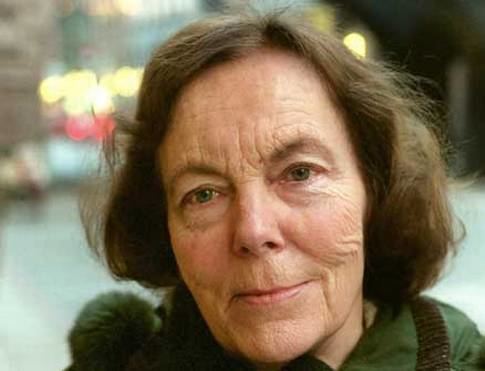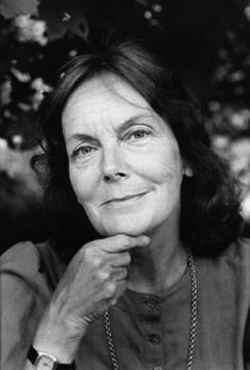Occupation journalist, writer Genre children Children Camilla Gripe Period 1954-1997 Spouse Harald Gripe (m. 1946) | Nationality Swedish Role Author Name Maria Gripe | |
 | ||
Born Maja Stina Walter25 July 1923Vaxholm, Sweden ( 1923-07-25 ) Died April 5, 2007, Salem Municipality Books Skuggan över stenbänken, Elvis Karlsson Movies Hugo and Josephine, Glasblasarns barn, Agnes Cecilia – en sallsa, Elvis! Elvis! Similar People Anders Gronros, Kay Pollak, Kjell Grede, Lasse Lundberg | ||
Maria Gripe, born Maja Stina Walter (25 July 1923 – 5 April 2007), was a Swedish author of books for children and young adults, often written in a magical and mystical tone. For her lasting contribution to children's literature she received the Hans Christian Andersen Medal for Writing in 1974.
Contents
- Biography
- Writing style
- Books in English translation
- Adaptations and translations
- Recognition for Gripes work
- References

Biography

Maja Stina Walter was born in Vaxholm, Uppland, Sweden. When Maria was six, her family moved from Vaxholm to Örebro. They moved again to Stockholm for her secondary schooling and studies at Stockholm University.
In 1946 she married the artist Harald Gripe, who created cover illustrations for most of her books. His illustration career, in fact, began in connection with his wife's debut as author of I vår lilla stad ("In our little town"). Maria Gripe's first major success was Josephine (1961), the first of a series of novels that later included Hugo and Josephine and Hugo.
During most of her adult life Maria Gripe lived in Nyköping, where an adaptation of her book Agnes Cecilia was filmed. After a long period of dementia Maria Gripe died at 83 in a nursing home in Rönninge outside Stockholm; her husband Harald had predeceased her by 15 years. Their daughter Camilla Gripe is also a children's author.
Writing style
Much of her writing, particularly the later work, is suffused with a supernatural or mystical element. This change in her writing style from her less mature work was partly a result of the influence of Edgar Allan Poe, Charlotte and Emily Brontë, and Carl Jonas Love Almquist, and partly a reaction to violence in entertainment that had begun to gain ground in cultural expression; Gripe sought to manufacture plot tension in less overt ways.
A prominent feature of Maria Gripe's writing is a respect for individuals and their unique characteristics, a trait which is especially perceptible in the social realism of the Elvis series, which she co-wrote with her husband Harald in the 1970s.
Another recurring leitmotif in Gripe's books is shadow, particularly in the series which began with Skuggan över stenbänken ("The shadow on the stone bench", 1982).
Books in English translation
Adaptations and translations
Gripe wrote 38 books, translated into 30 different languages, making her one of Sweden's most prolific writers. Her last published book is Annas blomma ("Anna's Flower", 1997). Several of Gripe's books have been filmed, such as Glasblåsarns barn (The Glassblower's Children), Agnes Cecilia: en sällsam historia ("Agnes Cecilia: a singular history") and the "Shadow" series, directed by Anders Grönros in the 1990s. Kjell Grade directed Hugo and Josephine in 1967, while Kay Pollak filmed Elvis! Elvis (Elvis and his friends) in 1976 and Flickan vid stenbänken ("The girl on the stone bench") became a television series in 1989.
Dramatized versions of Tordyveln flyger i skymningen ("The dung-beetle flies at dusk"), Agnes Cecilia and Tanten ("The Aunt") have been produced as radio serials. She also wrote the original Swedish television script for Trolltider ("Magic Time", 1979).
Recognition for Gripe's work
The biennial Hans Christian Andersen Award conferred by the International Board on Books for Young People is the highest recognition available to a writer or illustrator of children's books. Gripe received the writing award in 1974.
Stockholm University Literature professor Boel Westin praised Maria Gripe to a writer for Svenska Dagbladet, declaring that her Shadow books presented an exciting narrative that enabled readers to feel as if they were participants: "She has meant a lot. She renewed children's prose."
Literary researcher Ying Toijer-Nilsson, who wrote a biography Skuggornas förtrogna ("Confidant to shadows") of the author, echoed the remarks, saying that she would miss "the warm and humorous human being who was Maria Gripe." The biographer continued: "She has done a lot for the children's book world, and she got her readers to think about philosophy, about the world and about death." Toijer-Nilsson pointed out that Gripe's books also have "a significant tendency to support the social advancement of women."
Her books have won many awards, and she was the 1979 Swedish winner of the Dobloug Prize for Swedish and Norwegian fiction. In 1985 she was awarded the Nordic Children's Book Prize.
